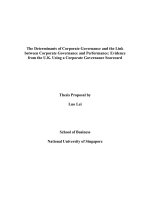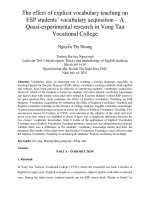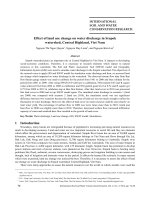Effect of supply chain coordination on supply chain flexibility empirical evidence from manufacturing companies
Bạn đang xem bản rút gọn của tài liệu. Xem và tải ngay bản đầy đủ của tài liệu tại đây (894.69 KB, 67 trang )
VIETNAM NATIONAL UNIVERSITY, HANOI
VIETNAM JAPAN UNIVERSITY
DUONG THI MINH NGUYET
EFFECT OF SUPPLY CHAIN
COORDINATION ON SUPPLY CHAIN
FLEXIBILITY: EMPIRICAL EVIDENCE
FROM MANUFACTURING COMPANIES
MASTER’S THESIS
VIETNAM NATIONAL UNIVERSITY, HANOI
VIETNAM JAPAN UNVERSITY
DUONG THI MINH NGUYET
EFFECT OF SUPPLY CHAIN
COORDINATION ON SUPPLY CHAIN
FLEXIBILITY: EMPIRICAL EVIDENCE
FROM MANUFACTURING COMPANIES
MAJOR: MASTER OF BUSINESS ADMINISTRATION
CODE: 8430101.01
RESEARCH SUPERVISORS:
Prof. GUO PEIJUN
Assoc. Prof. PHAN CHI ANH
Ha Noi, 2021
LETTER OF DECLARATION
I hereby declare that the Master thesis “EFFECT OF SUPPLY CHAIN
COORDINATION ON SUPPLY CHAIN FLEXIBILITY: EMPIRICAL EVIDENCE
FROM MANUFACTURING COMPANIES” is the results of my own study and has
never been published in any work of others. During the implementation process of this
project, I have seriously taken research ethics; all findings of this projects are results of
my own research and surveys; all references in this project are clearly cited according
to regulations.
I bear full responsibility for the fidelity of the number and data and other contents of my
graduation project.
Hanoi, 2 June 2021
Master student
Duong Thi Minh Nguyet
ACKNOWLEDGEMENT
First and foremost, it is my pleasure to show my special thanks to my supervisors at
Vietnam – Japan University, VNU - Assoc. Prof. Phan Chi Anh and Prof. Guo Peijun.
Without their assistance and dedication to every step throughout the process of the thesis,
this paper would have never been accomplished. I would like to thank them so much for
aspiring guidance, invaluably constructive criticism, and friendly advice during the
project work.
I am using this is opportunity to express my deepest gratitude to everyone who has been
with me and supported me over these past four years. I would like to thank all of the
faculty members and staff at Vietnam – Japan University, VNU for giving me the chance
to do this thesis. Especially, I have to thank program’s assistant, Mrs. Nguyen Thi
Huong who have properly handled all the problems that arose during the thesis.
Most importantly, I would like to extend my warms thanks to my parents for their
unconditional love, continuous encouragement throughout my process of learning and
maturation. This accomplishment would not have been possible without them.
Sincerely,
Duong Thi Minh Nguyet
Hanoi, 2021
TABLE OF CONTENTS
TABLE OF CONTENTS ................................................................................................ i
LIST OF TABLES .......................................................................................................... ii
LIST OF FIGURES ....................................................................................................... iii
LIST OF ABBREVIATIONS........................................................................................ iv
ABSTRACT ................................................................................................................... v
CHAPTER 1: INTRODUCTION ................................................................................... 1
1.1. Research scope ................................................................................................. 2
Place scope .............................................................................................................. 2
Time scope .............................................................................................................. 3
1.2. Structure of study: ............................................................................................ 3
CHAPTER 2: LITERATURE REVIEW ........................................................................ 3
2.1. Supply chain coordination ................................................................................... 3
2.2. Supply Chain Flexibility ...................................................................................... 7
2.3. Hypothesis development ...................................................................................... 8
2.3.1. Inter-organizational coordination and Supply chain flexibility ................... 8
2.3.2. The moderating effect of Information technology links ............................. 10
2.3.3. The moderating effects of Supply chain information sharing ..................... 11
CHAPTER 3: RESEARCH DESIGN .......................................................................... 13
3.1. High Performace Manufacturing (HPM) Project introduction ......................... 13
3.2. Analytical Framework ........................................................................................ 13
3.3. Survey instrument (Measurement scales) .......................................................... 15
3.4. Data analysis methodology ................................................................................ 17
3.5. Data Collection and Measurment Analysis ........................................................ 18
3.5.1. Measurement test and descriptive analysis ................................................. 19
3.5.2. Correlation analysis ..................................................................................... 19
3.5.3. Hypothesis testing ...................................................................................... 21
CHAPTER 4: DISCUSSION AND IMPLICATIONS................................................. 29
CHAPTER 5: CONCLUSIONS ................................................................................... 32
REFERENCES ............................................................................................................. 33
APPENDIX A ............................................................................................................... 39
APPENDIX B .............................................................................................................. 42
APPENDIX C ............................................................................................................... 51
LIST OF TABLES
Table 3. 1: Survey instruments ..................................................................................... 16
Table 3. 2: Correlation analysis .................................................................................... 19
Table 3. 3: Regression analysis..................................................................................... 22
Table 3. 4: Hierarchical regression analysis (Dependent variable: FLEXCN)............. 24
Table 3. 5: Summary of hypotheses test ....................................................................... 26
LIST OF FIGURES
Pages
Figure 3. 1: Proposed analystical framework ............................................................... 14
Figure 3. 2: Summarized moderating effects on Flexibility performance .................... 25
LIST OF ABBREVIATIONS
SC
Supply chain
SCC
Supply chain coordination
SCF
Supply chain flexibility
SCP
Supply chain performance
IOC
Inter-organizational coordination
ICSUP
Inter-organizational coordination with suppliers
ICBUY
Inter-organizational coordination with buyers
WITHSUP Supply chain information sharing with suppliers
BYSUP
Supply chain information sharing buy suppliers
WITHCUS Supply chain information sharing with customers
BYCUS
Supply chain information sharing by customers
LINKSUP
Information technology links with suppliers
LINKCUS
Information technology links with customers
ABSTRACT
The main purpose of this study is to empirically investigate an empirical study of the
relationship between Supply chain coordination practices (SCC) and Supply chain
flexibility (SCF) in various manufacturing companies. Multiple regression analyses are
used to analyse the data collected from 204 manufacturing plants in 12 countries
including China, Finland, German, Italy, Israel, Japan, Korea, Spain, Sweden, Taiwan,
United Kingdom, and Vietnam from the fourth round of a High-Performance
Manufacturing Project during 2014-2016. The analytical results confirm the closed
linkage between Inter-organizational coordination with suppliers and buyers (subdimension of SCC) and SCF. Moreover, this study also offers multidimensional aspects
of Information sharing and IT links to examine the effects on each relationship between
In-organizational coordination and SCF; then comparing to other Supply chain
performance. The analytical results indicate that Information sharing with/by customers
and IT links with customers plays a vital role in increasing the flexibility capability in
the supply chain. The main findings of this study suggest to supply chain managers that
SCF can be built up by focusing on both Inter-organizational coordination with suppliers
and buyers’ practices, and Information sharing with/by customers and IT links with
customers should be regarded as the facilitator to maximize the effect of Sup-ply chain
coordination on Supply chain flexibility.
Key words: Supply chain coordination, Supply chain flexibility, Inter-organizational
coordination, Supply chain Information sharing, Information technology links, Supply
chain performance.
CHAPTER 1: INTRODUCTION
During the last three decades, most academicians and practitioners have focused on
improving competitive advantages such as cost, quality, and distribution; however a
body of literature has started to recognize the importance of flexibility in term of Supply chain which is looked beyond manufacturing flexibility (De Meyer et al. 1989;
Stevenson et al. 2007, Tiwari et al. 2015, Manders et al. 2017). The move from the view
of production to supply chain can be seen as a need for supply chain partners to
collaborate to generate flexibility and, as a result, end-user responsiveness (Kumar et al.
2008). To improve the Supply chain Flexibility (SCF), supply chain members can act as
though they are part of a single system, coordinating with one another. Because of the
uncertainty in the supply chain, all of the company's operating areas need to collaborate
and communicate with the main vendors and buyers which demonstrates the important
of Supply chain Coordination (SCC). It is in charge of increased efficiency, such as an
annual sales limit, improved customer experience, and faster response times (Ronald H
Ballou et al. 2000, Arshinder et al. 2008, Hugos et al. 2011). In the SCC literature, most
of researchers explores the concept of Coordination from within the organization and
Coordination between organizations (Stank et al. 1999, Kim et al. 2001, Bas Hillebrand
et al. 2003, Melander et al. 2019). It is considered that internal cooperation as a
coordination mechanism for external cooperation in the supply chain context. In fact,
little studies examined deeply the relationship between firms and their external trading
partners (A. Campbell, 1994), thus, in this study the authors will investigate the
influence of Inter-organizational Coordination with suppliers and Inter-organizational
with buy-ers which are the sub-dimension of external SCC on SCF.
In addition, both SCF and SCC literature indicated the importance of Information
sharing and Information technology (IT) in improving supply chain performance.
According to Fawcett et al. 2007, the use of IT in a collaborative supply chain improves
both operational and competitive performance. The literature seems to be lacking in
investigating the degree of strong and weak impact of multi-dimensional aspects of
information sharing and IT links in the relationship of SCC impacts on SCF (Jayaram
et al. 2011). Therefore, this study considers SC Information Sharing and IT links as
factors moderating the relationship between SCC and SCF. This study adopts the
database from High Performance Manufacturing (HPM) projects which developed by a
group of academics from the University of Minneso-ta and Iowa State University began
in 1989 in the United States (Schroeder and Flynn, 2001). In addition, we would like to
compare the empirical results between Inter-organizational coordination and other SC
perfor-mance like quality, cost, speed, on-time delivery via moderating effect to the
flexibility perfor-mance in the SC measurement scales.
In summary, the objective of this study includes:
•
To develop an empirical framework for analysing the relationship between Inter-
organizational collaboration and supply chain flexibility. The moderators in this
relationship are four categories of SC information sharing and two types of information
technology links from various industries and countries.
•
To synthesize the theoretical background of Supply chain coordination and
Supply chain flexibility, especially the different level of Inter-organizational
coordination with Supplier and with customers impacts on SC performance: quality,
cost, speed, on-time delivery, and flexibility.
Based on the context and current literature, this study has 2 main research questions:
•
What is the effect of Inter-organizational coordination on SC flexibility?
•
How do the moderating effects of SC information sharing and IT links to leverage
the rela-tionship between Inter-organizational coordination and SCF, and comparing to
other SC perfor-mance like quality, on-time delivery, speed and cost?
1.1.
Research scope
Place scope
This study uses data collected from 13 countries including: United Kingdom, Finland,
Brazil, German, Italy, Spain, Sweden, Israel, Japan, Korea, China, Taiwan, and
Vietnam; with the sample consists of 204 manufcaturing firms. The database were
collected from Round fourth of HPM projected which initiated from 1989 in The U.S.
The details of project will be explained later in this paper.
2
Time scope
The data from fourth round of HPM project was collected from 2014-2016. This is the
newest database of this project and still continuous conducting to find out the best
practices to high performance in manufacturing companies.
1.2.
Structure of study:
The structure of this study firstly began with the Literature review which provides
overview of previous studies about the concepts, practical insight. Secondly, the author
goes to illustrate the research design which shows the analytical framework with
hypothesises and measurement scales explaination. The next session will be the data
collection and analysis, in which research methodology and data collection will be
analyzed, the results are showed afterwards. Then, the author indicates the main findings,
dicussions, and gives some practical the implications. Finally, concluding the main
contributions of this study, also idenfifying the limitations and suggesting some
directions for future research.
CHAPTER 2: LITERATURE REVIEW
2.1. Supply chain coordination
In SCM, supply chain coordination is crucial because it is in charge of increased
efficiency, such as an annual sales limit, improved customer experience, and faster
response times (Ronald et al. 2000, Hugos et al. 2001, Arshinder et al. 2008). Members
of the supply chain cannot compete on their own. Because of the uncertainty in the
supply chain, all of the company's operating areas need to collaborate and communicate
with their main vendors and buyers. Despite the increasing number of studies on
coordinating in SC, there is no common definition of Coordination due to various
perspectives related to a different context (Bas Hillebrand et al. 2003, Arshinder et al.
2011, Vosooghidizaji et al. 2019). The definition of Coordination accepted by most
research is “the act of managing dependencies between entities and the joint effort of
entities working together towards mutually defined goals” (Malone et al. 1994). The
study by Simatupang et al. 2002 viewed the act of effectively incorporating (relating,
3
harmonizing, adjusting, aligning) a variety of things (actions, goals, decisions, facts,
skills, and funds) to achieve the chain objective can be defined as coordination in the
SC. From the customer's perspective, coordinating the order fulfillment rate to actual
balance consumption effectively meets the customer's distribution deadline and reduces
logistics costs (Melander et al. 2019). According to Arshinder (2008) assumed that
“when used in the supply chain context, terminology like integration, collaboration,
cooperation, and Coordination are often complementary and often opposite to one
another but can generally be considered a part of the SCC”. Since the components of
coordination include inte-gration (combining to form an integral whole), collaboration
(working together), and cooperation, this assumption can be observed without lacking
generality (joint operation).
Many prior studies discuss the benefits of coordination regarding reducing the cost/risk,
im-prove quality performance, and increase the competitive advantages, business
performance (Sahin and Robinson 2005, Arshinder et al. 2008, Carr et al. 2008). Several
kinds of research show the benefits of effective SCC, including “the elimination of
excess inventory, reduction of lead times, increased sales, improved customer service,
efficient product developments efforts, low manufacturing costs, increased flexibility to
cope with high demand uncertainty, increased customer retention, and revenue
enhancements” (Lee et al. 1997, Horvath et al. 2001). However, in the ten recent years,
the wave of researches move to study fostering collaborative partnerships among supply
chain partners to achieve efficiencies, flexibility, and market responsiveness (Eric et al.
2007, Gilbert et al. 2010, Jayaram et al. 2011, Ravinder et al. 2013, Umar et al. 2017).
There is no unique way of classifying Coordination viewed in the supply chain. It
showed various perspectives of Coordination like Organizational economics (Theory of
the firm, Transaction cost economics), Information processing (Organization theory),
Group perspective (Transactive memory systems theory, collective mind), Practice
perspective (Social theory). Some perspectives show the inherent skills or intangible
values required for Coordination, such as responsibility, reciprocity, collaboration, and
trust. Various other perspectives believe that Coordination Based on the joint efforts
required to achieve common goals in different supply chain operations. There are
4
different expectations of different stakeholders and different activities; the coordination
requirements also vary with the complexity of the operation.
More empirical research is needed on the proper execution of coordination mechanisms
so that the effect of coordination on various SC efficiency metrics can be captured using
a variety of different feasible coordination mechanisms (Gilbert et al. 2010). The
literature review shows that many studies on dimensions of SCC are overlapped; the
author argued that SCC works could be divided into two aspects from competence
perspectives: Intra-firm and inter-firm coordination. Some studies explore it into
internal and external collaboration/ cooperation (Stank et al. 1994, Kim et al. 2001,
Hillebrand et al. 2003). Internal cooperation is a condition for successful and productive
external cooperation, which implies that both internal and external cooperation can be
examined together (Hillebrand et al. 2003). There are some theoretical views related to
the importance of Coordination within and between organizations (Intra-organizational
and Inter-organizational Coordination) to achieve better organizational outcomes.
Melander et al. (2009) argued that Inter- and Intra-organizational coordination
challenges are interrelated. To maximize the capacity for turning competitive advantage
into profitability, a company must establish efficient Coordination both inside and
beyond its walls (Dyer and Singh, 1998). Arshinder et al. (2011) indicated that
expanding the concept of Coordination from within the organization to Coordination
between organizations is the most challenging view for researchers. There are clear
indications that both types of cooperation are related despite that only little attention has
been devoted to the relationship between internal and external cooperation (Hillebrand
et al. 2003). Flynn et al. (2010) studied SC collaboration refers to the degree to which
“a manufacturer strategically collaborates with its supply chain partners and
collaboratively integrates intra- and inter- organizational processes to ensure effective
and reliable exchanges of products and resources, information, properties, and decisions
in order to provide maximum value to the customer”. Internal (Intra-organizational)
Coordination can be seen as inter- functional Coordination, which refers to the degree
of cooperation between the different departments within the organization (Hillebrand et
al. 2003). Flynn et al. (20100 said that as part of a firm's internal coordination, divisions
and roles within a manufacturer should work as part of an interconnected operation.
5
External integration (Coordination) identified the importance of establishing close,
interactive relationships with customers and suppliers. Both views are critical for supply
chain participants to work in concert to increase the supply chain's value.
Inter-organizational coordination (IOC) is when more than two organisations
collaborate to accomplish a common purpose, complete a mission, or deliver a service.
When members of two or more organisations may achieve reciprocal advantages or
profits by communicating, they form relationships (Sol Levine and Paul E. White, 1961).
Since they are both inspired to combine their activities for mutual benefit, the essence
of the relationships is marked by a high degree of teamwork and problem solving.
Coordination and collaboration between institutions exists in order to procure the scarce
elements and optimize mission achievement. IOC, according to Carr et al. (2008),
reduces environmental risks which can be pointed to as an improvement in supply chain
reliability when SCF deal with the uncertainties. In inter-organizational relationships,
the sharing of vital expertise and intelligence for the firms' success can only be
accomplished by dynamic personal and social experiences. Personal and indirect
mechanisms of collaboration are used to manage inter-organizational partnerships as a
social management tool. Also, Inter-firm collaboration mechanisms characterized by
efficient connectivity, knowledge sharing, collaborating, and success management were
analyzed by Stank et al. 1999. Managers must be encouraged to look at ways to
collaborate with outside players to improve SCF. It is much easier to claim than it is to
do when it comes to supply chain management and fostering closer communication with
supply chain suppliers (Angkiriwang et al. 2014)
In this study, the author investigates Inter-Organaizational coordination (IOC) – subdimension of SCC, whereas IOC with suppliers and IOC with buyers are subdimensions of IOC, which refers to firms/plants coordinate all activities like Strategic
Planning, New product development planning, Information Sharing, Production
Planning Cooperation, and the use of an integrated network with suppliers and
customers.
6
2.2. Supply Chain Flexibility
In the era of SCM, an increasing body of research is examining the importance of
moving beyond the flexible factory to the flexible supply chain. Supply chain Flexibility
rapidly evolving area of research, with numerous views, conceptualizations, and metrics.
However, there are no unique definitions that are broadly accepted (Dileep et al. 2008,
Stevenson et al. 2007). The term “Flexibility” has been investigated in the 1980s and
the term SCF has well evolved from the view of manufacturing firms (Olhager et al.
2002, Upton et al. 1994). In the manufacturing context, “Flexibility is considered the
ability of a system to deal with changes (Gupta et al. 1989), or ability to change or react
with little penalty in time, effort, cost or performance” (Upton et al. 1994). Flexibility
is seen by academics as a response lever that businesses use to handle uncertainty and
transition in both internal and external contexts. The majority of research on SCF sees
it as a functional expansion of manufacturing flexibility, and it's approached from a
process-based and organizational standpoint (Vickery et al. 1999, Malhotra et al. 2012,
Tiwari et al. 2015).
The literature on flexibility is divided into two categories: operational interests and
organizational functions. The organizational factors are apparent in the researchers'
emphasis on time, expense, and variety as main dimensions of versatility, which indicate
an inclination toward operational responses to changes occurring both internally and
externally. Procurement, processing, delivery, and knowledge s are some examples of
corporate stability roles. Thus, some research has been done on the SCF focused on
business functions such as product creation, sourcing, engineering, logistics, delivery,
communications, and information systems (Manders et al. 2017). However, there is a
lot of variation in these aspects, which makes the SCF definition and relationships
challenging to understand. According to Kumar et al. (2008), from the customer's view,
there are five aspects of SCF to consider: manufacturing, designing new products,
product customization, responsiveness, and shipping finished products. Fayezi et al.
(2016) defines SCF as a structure or network of interconnected external (inbound and
outbound) and internal manufacturing flexibilities that, when combined, aid the focal
firm's customer-oriented performance outcomes. Kumar et al. (2013) studies SCF
7
flexibilities dimensions based on the Flow of supply chain: Inbound, In-house and
Outbound.
Academics and practitioners have gained a greater understanding of the basic concepts
of SCF thanks to the efforts of a number of scholars. SCF, according to Fayezi et al.
(2016), is an operational capacity that allows organizations to adapt to internal and
external uncertainties by successfully integrating SC relationships within and/or within
their major partners. The ability of the SC to respond, adapt, and adjust to meet changing
market demand is the general principle of SCF, which is commonly used by analysts
and supply chain managers.
In different experiments, SCF has been conceptualized in several ways. Some
researchers measure SCF when it comes to (product quality, time performance, and
inventory performance). Besides this, customer satisfaction metrics were used in other
research to capture performance benefits (Anderson et al. 1998, Das et al. 2000).
Customer flexibility, or the willingness of the focal organization and its main customers
to react quickly to shifts in customer orders (Zhang et al. 2009), is referred to as
downstream SCF. The synthesis summary of definitions and dimensions of SCF is
presented in Appendix A. This study follows the concept of SCF as the degree to which
a company meets its end users' needs quickly by efficient management of the
competencies of various organizations in the SC, which is measured by the Supply
Chain Management scales (Ability to meet customers’ flexibility needs) in the HPM
codebook round fourth. The following definition of flexibility is grounded from the
Sand cone model of (Ferdows and Meyer, 1990) in manufacturing context: Flexibility
(or reaction speed) is the cumulative capacity of quality enhancement and dependability
of the production systems.
2.3. Hypothesis development
2.3.1. Inter-organizational coordination and Supply chain flexibility
To boost supply chain flexibility, some authors have acknowledged the significance of
greater co-ordination and collaboration (Pujawan et al. 2004, Vokurka et al. 2000).
Coordination among members of the SC upstream and downstream is not a zero- sum
game; it decreases costs for all parties (Porter, 1985), based on the Sand cone model
8
(Ferdows and Meyer, 1990) it implies that SCC improves quality performance, reduce
delivery time, increase speed, such accumulative of these performance leads to enhance
the flexibility. Improved supply chain coordination, thus, will result in cost reduction,
improved quality, improved performance, and greater flexibility in meeting consumer
demands (Kumar et al. 2013). High-quality standards, on-time deliveries, and reliable
supply-chain operations cannot be guaranteed by a single entity but must be ensured by
cooperation and partnership with trading partners. While the literature in supply chain
coor-dination shows several types of coordination, this paper focuses on interorganizational coordi-nation with downstream and upstream supply chain management.
The term “external supply chain coordination”, “external integration”, “Interorganizational coordination” are interchangea-ble. The degree to which a manufacturer
collaborates with its external partners to organize its inter-organizational strategies,
processes, procedures, and behaviours is referred to as external integration (Chen et al.
2014, Flynn et al. 2010). Effective communication, information exchange, collaboration,
and performance monitoring define inter-firm coordination procedures (Stank et al.,
1999). Managers are encouraged to look at ways to collaborate with outside players to
improve supply chain flexibility (Angkiriwang et al. 2014). External coordination with
supply chain participants is essential for gaining a better understanding of the industry,
optimizing product efficiency, increasing strategic capabilities (Mostaghel et al. 2015),
and reducing costs and product cycle time and flexibility capability (Braunscheidel et
al. 2009). Mckone-Sweet et al. (2009) describe cross- functional and interorganizational collaboration activities aimed at boosting flexibility for quickly changing
market requirements in terms of diversity and speed. In the supply chain integration
based view, almost all literature shows that inter-organizational coordination with
suppliers enhances the operational efficiency, especially product quality performance in
New product development context (Carr et al. 2008), but little empirical study pays
attention to the flexibility performance and the extent to which inter-organizational
coordination with the supplier and inter-organizational coordination with buyers
influences it. According to Sandcone model, Flexibility is the cumulative capacity of
quality enhancement, dependability, and speed of the production systems. Thus, this
paper develops the following hypotheses to test the theoretical framework.
9
Hypothesis H1a: Inter-organizational coordination with suppliers is positively related to
Supply chain flexibility.
Hypothesis H1b: Inter-organizational coordination with buyers is positively related to
Supply chain flexibility.
2.3.2. The moderating effect of Information technology links
Information technology (IT) in supply chain management has been proved the
importance in SCC and SCF literature from both researchers and practitioners (Li, Ling
2012). Many researchers find IT as enablers for SC integration (Chae et al. 2005) and
SC performances, whereas other recent studies carry the empirical test of the moderating
role of IT in the relationship between SCC and organizational performance (Zhao et al.
2016). The use of computer applications, programs, and networks is referred to as information technology. IT is seen as having several advantages in supply chain management,
including increased quality performance, on-time delivery, and flexibility capability.
The literature of IT classifies several types of connection, this paper only focuses on the
IT link with upstream and downstream supply chain and investigating how IT link to
interact with different supply chain coordination and flexibility performance. The use
of digital processes or computer-to-computer connections between businesses and their
vendors and consumers is known as IT link with suppliers and IT link with customers
respectively (Carr et al. 2002). Supply chain management systems connect suppliers,
and customer relationship management connects customers. The reliability of the supply
chain can be achieved when the IT structure in the supply chain is ensured in terms of
continuity, connectivity, and consistency (Ye et al. 2013). While the advantages of an
IT link or IT coordination for marketing and financial results have been shown, the
impact of IT on supply chain performance is still debated. Joining an IT network, for
example, would boost vendors' costs because a quick-response service resulted in
further supply sales, as well as their inventory keeping costs. IT links with external
partners refer to the ability to apply inter-organizational IT tools to enhance SC
performance. The IT links with supplier and customers may strengthen the relationship
between SCC and SCF because it facilitates the opportunity to gain smoothly knowledge
from other partners by accessing real-time information about inventory to reduce cost,
10
quality control, and on-time delivery. Therefore, the author develops related hypotheses
as following:
Hypothesis H2a: Relationship between Inter-organizational coordination with suppliers
and SCF is stronger with higher IT links with suppliers.
Hypothesis H2b: Relationship between Inter-organizational coordination with buyers
and SCF is stronger with higher IT links with suppliers.
Hypothesis H2c: Relationship between Inter-organizational coordination with suppliers
and SCF is stronger with higher IT links with customers.
Hypothesis H2d: Relationship between Inter-organizational coordination with buyers
and SCF is stronger with higher IT links with customers.
2.3.3. The moderating effects of Supply chain information sharing
Information sharing has been widely recognized for the important role in SC. The
activity of making information accessible to other members of the chain is referred to
as an information-sharing activity (Kembro et al. 2014, Kumar et al. 2012). Previous
research has shown that information sharing activities have a direct impact on supply
chain performance and IS as the enablers for SCC. Manufacturers can access different
information such as revenue, manufacturing, and logistics through supply chain
information exchange, which improves visibility and reduces confusion (Robert et al.
2002). Supply chain integration, according to Sezen (2008), will increase operating
efficiency by lowering material sourcing prices, promoting quality assurance activities,
and increasing flexibility to adapt to consumer needs. Information sharing enables
businesses to collaborate with their vendors and customers, allowing them to build
loyalty, which leads to stronger long-term relationships. Shorter lead times and order
delivery cycles, as well as a simpler and higher-quality new product production process,
are all advantages of this long-term partnership (David et al. 2012). Many articles
highlight the numerous advantages of information sharing for supply chains, but
academics warn that these advantages are not always guaranteed. It is dependent on the
type of information, the intensity of the information, how the information is provided,
and how the information is exchanged across supply chain participants. Information
sharing should be considered under upstream and downstream perspectives
11
independently (Chen et al. 2003). Whereas, Customer information sharing, on the other
hand, allows numerous sorts of data to be shared between manufacturers and customers
(Wu et al. 2014), as well as supplier information sharing permits manufacturers and
suppliers to communicate a variety of data types. SA number of studies provided
empirical evidence of how information sharing leads to collaborative practices then
improve performance, however, most of them consider the relationship of the firm with
supplier or customer only or combine as a single construct (Amrik et al. 2013, Wu et al.
2014, Kumar et al. 2011). In addition, existing empirical studies mainly investigate the
direct impact of information sharing on Inter-organizational coordination and SCF,
rather than considering how information sharing moderates the relationship between
them. This paper develops the hypotheses as below:
Hypothesis H3a: Relationship between Inter-organizational coordination with suppliers
and SCF is stronger with higher SC information sharing with suppliers.
Hypothesis H3b: Relationship between Inter-organizational coordination with buyers
and SCF is stronger with higher SC information sharing with suppliers.
Hypothesis H3c: Relationship between Inter-organizational coordination with suppliers
and SCF is stronger with higher SC information sharing by suppliers.
Hypothesis H3d: Relationship between Inter-organizational coordination with buyers
and SCF is stronger with higher SC information sharing by suppliers.
Hypothesis H4a: Relationship between Inter-organizational coordination with suppliers
and SCF is stronger with higher SC information sharing with customers.
Hypothesis H4b: Relationship between Inter-organizational coordination with buyers
and SCF is stronger with higher SC information sharing with customers.
Hypothesis H4c: Relationship between Inter-organizational coordination with suppliers
and SCF is stronger with higher SC information sharing by customers.
Hypothesis H4d: Relationship between Inter-organizational coordination with buyers
and SCF is stronger with higher SC information sharing by customers.
12
CHAPTER 3: RESEARCH DESIGN
3.1. High Performace Manufacturing (HPM) Project introduction
Many companies are looking for competitive advantages to survive in the highly volatile
global competition. Especially the manufacturing firm, they are seeking ways to
enhance the firm performance by applying either knowledge in practices in a different
context or the knowledge from theories. From both the theoretical and empirical point
of view, the aim of the High-performance manufacturing project was to do a systematic
review of the literature in the areas of operations management, strategic management,
organizational behavior, organization philosophy, human resources management, and
international business. Then, the database of information about high-performance
manufacturers in the United States, Europe, and Asia will be empirically developed in
comparison with traditional firms. Round one of this project was started in 1989 in the
United State by a group of researchers from the University of Minnesota and Iowa State
University and is today at its fourth round of data collection including more than 500
plants in about 18 countries. This study uses the data from the fourth round with the
participating 13 countries from the United Kingdom, Finland, Brazil, German, Italy,
Spain, Sweden, Israel, Japan, Korea, China, Taiwan, and Vietnam. The qualitative and
quantitative data were examined by the employees and managers knowledgeable in that
area. It provides a perspective on implementing similar practices in countries that differ
in national culture, governance style, history, manufacturing plant size, and other
important factors.
3.2. Analytical Framework
From our intensive literature review, we focus on Inter-organizational coordination
practices and Supply chain Flexibility including:
13
SC information sharing
with/by suppliers
SC information sharing
with/by Customers
Supply chain Coordination
Interorganizational
Coordination with Supplier
Supply chain Flexibility
Interorganizational
Coordination with Buyers
IT Link with
Suppliers/Customers
Figure 3. 1: Proposed analystical framework
In which, each variables (taken from HPM codebook) in this framework is described as
follow:
-
Inter-organizational coordination includes Inter-organizational coordination with
supplier and Inter-organizational coordination with buyers: refers to the degree to
which a manufacturer collaborates with external partners to structure interorganizational processes, practices, procedures, and activities. (Chen and Paulraj,
2004; Zhao et al., 2011). Or indicating the extent of involvement of your plant in the
following activities with your primary Buyers/ Suppliers.
-
Supply chain information sharing with Supplier/Customers: The company
actively sharing information to its Suppliers/Customers such as: Cost information,
delivery information, demand change information, Demand forecast information,
Information on the production capability of plants, Inventory information,
Productivity information, Quality information, Schedule information,
-
Supply chain information sharing by Suppliers/Customers: describes the
company is able to be recieved the Suppliers/Customers’ information like: Cost
14
information, Delivery information, Demand change information, Demand forecast
information, Inventory information, Production capacity information, Productivity
information, Quality information, Schedule information.
-
Information technology links with Suppliers/Customers: refers to the electronic
tools are used to communicate with suppliers and consumers about sales processing,
procurement requests, invoices, and/or funds, and shipments are tracked using
technologies (such as RFID or PIDT).
-
Ability to Meet Customers’ Flexibility Needs (FLEXCN): describes the extent to
which flexibility is valued by the downstream supply chain.
3.3. Survey instrument (Measurement scales)
To test established hypotheses, the author use a set of HPM questionaires items which
is presented in Table 3.1:
15
Table 3. 1: Survey instruments
“Constructs
Code
Measurement items
Supply chain coordination
Interorganizational
ICSUP
coordination with suppliers
-
Strategic planning with suppliers
-
Planning for new products and programs with
suppliers
-
Planning for product conception and design with
suppliers
-
Sharing operational information
-
Coordination of production planning
-
Utilization of integrated database for information
sharing
Interorganizational
ICBUY
coordination with buyers
-
Strategic planning with buyers
-
Planning for new products and programs with
buyers
-
Planning for product conception and design with
buyers
-
Sharing operational information
-
Coordination of production planning
-
Utilization of integrated database for information
sharing
“Supply chain Information sharing
With/by Suppliers
WITHSUP
BYSUP
With/By Customers
WITHCUS
BYCUS
-
Cost information
-
Delivery information
-
Demand change information
-
Demand forecast information
-
Information about plant manufacturing capabilities
-
Inventory information
-
Production capacity information
-
Productivity information
-
Quality information
-
Schedule information
-
Cost information
-
Delivery information
-
Demand change information
16
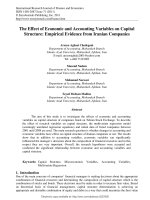
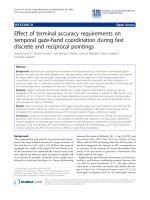

![kwon et al - 2014 - the effect of mandatory audit firm rotation on audit quality and audit fees empirical - evidence from the korean audit market [mafr]](https://media.store123doc.com/images/document/2015_01/06/medium_har1420548188.jpg)
![ionescu - 2014 - the effect of mandatory partner rotation on audit quality [mapr]](https://media.store123doc.com/images/document/2015_01/06/medium_fam1420548198.jpg)

